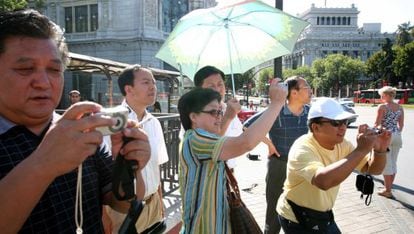Tourism from Asia driving changes to Spanish sector
Spain needs to expand its sun-and-sand model to lure travelers from emerging nations

Last year, nearly 65 million international travelers arrived in Spain, attracted mostly by its coast.
If the country manages to keep up the current trend in tourism growth, by 2030 it could be receiving as many as 90 million tourists, according to Simón Pedro Barceló, director of the Barceló hotel chain, speaking at an international tourism summit held on April 15 and 16 in Madrid.
A report published this week by the World Travel and Tourism Council, which organizes the summit, warns that despite growing investment, tourism in some European countries could suffer as a result of subpar airport and hotel infrastructure.
Technology and a growing middle class in emerging countries are creating a customer revolution”
Ana Patricia Botín, CEO of Santander Group
In theory, Spain’s airport network is ready to receive those hypothetical 90 million tourists. Last year Madrid-Barajas recorded 42 million travelers – the opening of Terminal 4 in 2006 raised the hub’s total annual capacity to 70 million passengers.
“But Spain will not continue to grow through the sun-and-sand model. It has to get ready for a new model,” said Barceló.
Spain ranks third globally in tourist arrivals, and over half of visitors come from the UK, Germany and France. But these sources have their limits, and if Spain wants to remain a tourism powerhouse, it must seek out new markets and attract the growing middle classes from Asia and Latin America.
“That’s where we really need to do our homework,” says Barceló. “In order to reach them, we need to adapt to their needs, which go beyond the beach.”
Chinese visitors are not attracted by the sun and the sand the way many Europeans are – for cultural reasons, they tend to avoid getting tanned. Yet on the other hand, China is experiencing a growing wave of interest in wine culture.

“Spanish wine will win the commercial battle through enotourism, which still needs to be developed more,” says José Luis Bonet, president of the Freixenet winery and chairman of the Spanish Chamber of Commerce.
Shopping is also a popular option with tourists from Asia, the Middle East and Latin America.
“But this requires adaptation. You can’t have a customer come to your store and be told to come back the next day because you don’t open on Sundays,” says Desirée Bollier, president of Value Retail, a company that specializes in outlets selling luxury brand products.
According to Ana Botín, CEO of the Santander banking group, Spain has to prepare for “the customer revolution.”
“Technology and a growing middle class in emerging countries are creating a customer revolution,” said Botín last Thursday, speaking before an audience of hundreds of executives from the tourism industry.
“Companies in Spain are innovative,” she continued. “We have a good climate, good food and marvelous cultural options to offer. We could be the Florida of Europe.”
But that will require focusing on visitors’ needs, and the best tool for that might be the mining of “big data.” Botín believes that the tourism sector, just like banking, can benefit from the abundance of information left behind by tourists regarding their tastes, schedules and even their obsessions. New technologies, she said, need to be at the heart of that process.
David Scowsill, president of the World Travel and Tourism Council, compared this digital adaptation to “the advent of jet engines and the challenges once posed by low-cost airlines. Wherever we look, the traditional way of doing things is being questioned.”
But for Spain, there is an added challenge besides giving customers what they want: businesses also need to turn a profit from tourism. Average spending remains stationary, travelers are looking for low prices, and Spain is competitive in that respect.
How to get some tourists to spend more? Botín offered the example of the Matutes Group in Ibiza. “They have refurbished many hotels along the coast to create a new concept that adapts better to what people want,” she said. “Ibiza has become the [Spanish] destination with the greatest per capita spending. And it’s not just hotels who benefit, but also taxi drivers, souvenir salespeople, restaurants and others.”










































